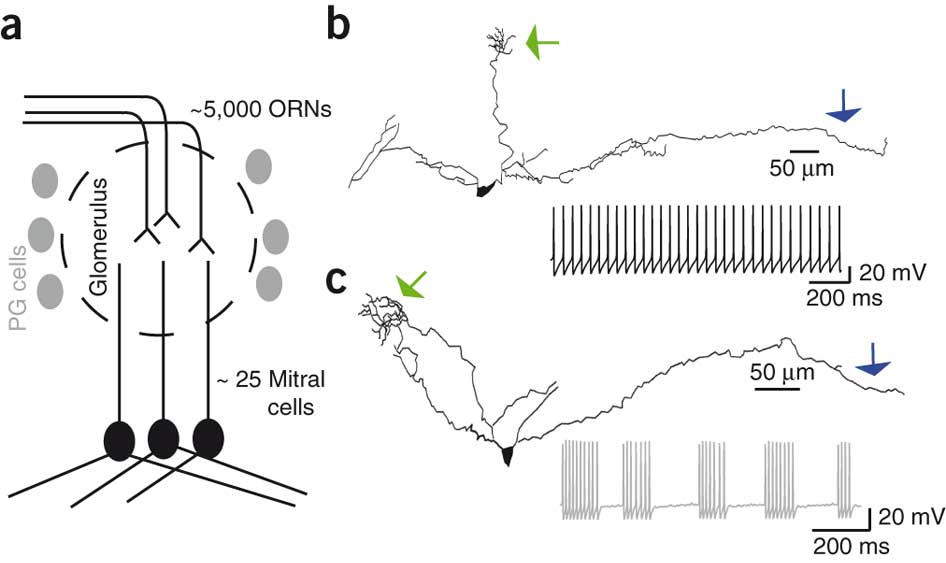During my flyfishing vacation last year, pretty much nothing was happening on this blog. Now that I’ve migrated the blog to WordPress, I can actually schedule posts to appear when in fact I’m not even at the computer. I’m using this functionality to re-blog a few posts from the archives during the month of august while I’m away. This post is from October 25, 2010:
Brains are what mathematicians call “information sources“. At least this is one of the results of a set of elaborate experiments together with sophisticated analyses and computations reported in the current issue of Nature Neuroscience (subscription required). The article, entitled “Intrinsic biophysical diversity decorrelates neuronal firing while increasing information content”, studies a set of neurons in the brain’s main olfactory center, the olfactory bulb. These neurons, mitral cells, receive input from olfactory sensory neurons with their receptors in the olfactory epithelium in the nose. The authors looked at particular subsets of these neurons in the mouse brain, namely the ones that receive their input within a single identical so-called ‘glomerulus’, a neuropil structure characterized by the fact that it contains only the terminals from olfactory receptor neurons that express the same olfactory receptor. This means that the input these mitral cells receive is highly correlated. In other words, these mitral cells receive virtually identical stimulation and the authors looked at the output these neurons generate in response to the input.
In order to do this, the used patch electrodes to stimulate and record from these neurons. In order to provide realistic input scenarios, they passed more or less random amounts of current into one neuron at a time and then evaluated their output. What they found was that each neuron seemed to look at a different aspect of the input, leading to this population of cells to lose the correlation in their activity that is present in their input. Put differently, every neuron reacts differently to the same input and even if you give all mitral cells in the same glomerulus the same input (like the same smell), each mitral cell will respond with a different train of activity degrading any correlation that might have been present in the input.
This all make a lot of sense, because in this way, each neuron looks at the same stimulus from a slightly different perspective, enhancing the amount of information the animal can get from a single stimulus. From the point of view of information coding, this is an advantage, that comes with a disadvantage: some neurons will create ‘phantom’ information, information that isn’t there. The authors do not mention this with a single word, but they show it in their first figure:

In a) you can see the olfactory receptor neurons projecting into a single glomerulus and the mitral cells which receive their input. In b) and c) you see examples of mitral cells and their recordings to a single, depolarizing constant current. While one neuron, b), does what one would expect with constant input – constant output, i.e., firing – the other neuron, c), shows irregular, bursting activity that doesn’t reveal the constancy in the input signal at all. To put it drastically, one could say that this neuron is ‘hallucinating’. This example shows very clearly the drawback, in terms of information coding, of neurons decorrelating correlated input: some of the information the transmit may not be present in the sensory input at all. Already at this very early stage, the very first synapse after the sensory neurons, the brain is already altering, expanding and interpreting the sensory signal. In fact, it’s already making up its own information that is independent from the outer world. This is profound!
I’ve been thinking about the conundrum of ‘noise in the brain‘ before and already before this publication now, it has been very suggestive to argue that the variability in neural activity is not just random, pernicious noise but has some functional significance – a significance which we don’t quite understand, yet. The authors here argue that one part of that significance is to capture all the information in a sensory stimulus. I’d agree with that but from their experiments I’ll take another function which they don’t mention: the capability to react slightly differently to always the same stimulus. This capability of doing things differently every time the same situation comes along is vital for survival. Here’s a great example of what can happen to you, if you don’t do that and react always with the same response to the same stimulus:
Tentacled snakes hunt by exploiting the predictability of fish: they elicit a so-called C-start response in their prey in order to predict where the fish will be going, only to then intercept the fish’s escape path. The result: the fish swims right into the mouth of the snake. This video was published by Ken Catania, who studies these animals.
The results by Padmanabhan and Urban provide further evidence that the highly variable activity of neurons is not ‘noise’ in a complex system, but actively generated by the brain not only to increase information capacity, but also to behave unpredictably, creatively and spontaneously in an unpredictable, dangerous and competitive world.
It also means that adding information to a sensory stimulus may be a disadvantage in terms of information coding, but it wasn’t eliminated by evolution because it prevented animals from becoming too predictable – a classic cost/benefit trade-off. All this happens already at the very first synapse after sensory transduction – how much information is added in the more central stages of computing in the brain? Methinks, the question is not “why do some people hallucinate?”, the question should be, “why don’t we all?”…
Padmanabhan, K., & Urban, N. (2010). Intrinsic biophysical diversity decorrelates neuronal firing while increasing information content Nature Neuroscience, 13 (10), 1276-1282 DOI: 10.1038/nn.2630













